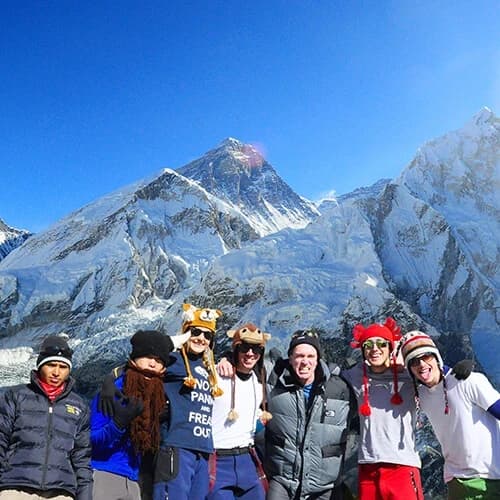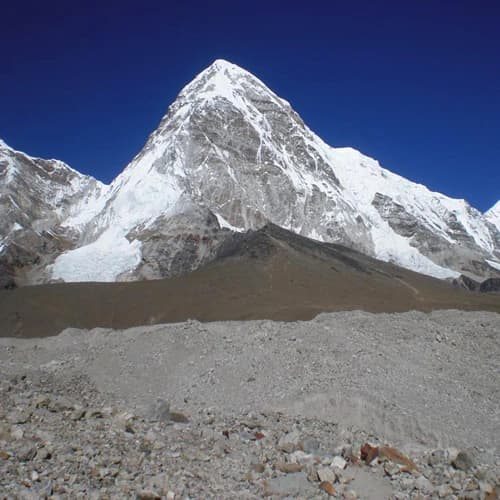Slow and steady wins the race!
If you've spent your entire life in the Himalayas, like the native Sherpas, your body will be used to high elevations, but for the rest of us, the acclimatization process will take some time. That is why, as inconvenient as it may be, gradual ascent is an important aspect of the acclimatization process.
Getting the pace appropriate on the Everest Base Camp Trek is critical to your success! At Outfitter Nepal, we know how to safely transport you to Everest Base Camp and back down. This isn't to say that you should show up unprepared.
You must be well-prepared and prepared for the Everest region trek. Descending is much more difficult than ascending, thus leg strength is something to consider! Climb at a comfortable pace for you. Don't try to go too fast or do too strenuous of a workout.
Acclimatization is really important!
To begin, incorporate as much acclimatization as possible into your schedule. Spending longer time at higher elevations will offer you a safer exposure in a low-oxygen environment. This extra time during the acclimatization phase encourages the growth of more red blood cells, which allows you to transfer more oxygen and safely ascend to greater elevations.
Because just a few people make up to the Everest region, acclimating well lower down before moving higher is essential. Years of experience have taught us that if you acclimate for less time than we recommend, you risk acquiring severe AMS (high altitude sickness). Your odds of success drop as you spend fewer days acclimatizing. This is why we strongly advise you to take advantage of your acclimatization opportunities.
Hydrate yourself and have plenty of fluids!
Dehydration is no laughing matter even in non-mountainous settings, therefore staying hydrated while trekking to Everest Base Camp should be one of your top priorities! Dehydration can aggravate the development of altitude sickness and make you exhausted faster. Because the human body dries out at higher altitudes, staying hydrated is critical for a successful trek.
At higher altitudes, the human body loses water more quickly than at sea level. When trekking to high altitudes such as Everest Base Camp, your body works hard to obtain more oxygen, which is why staying hydrated is essential. To minimize altitude sickness, muscle cramps, and dehydration, consume at least 3.5-4 litres of fluids each day (water, soup, and hot liquids). We suggest fluids such as green tea, lemon tea, hot lemon, ginger tea, and garlic soup (which is a must) as well as fresh vegetable products at high elevations.
If you get cold water in your bottle while trekking, you must either filter it using purification pills or get a SteriPen before drinking it! As a result, make sure you have adequate water purification tablets with you on your trip. While you could carry a device like a SteriPen on the trip, we've found that using tablets is the handiest, most effective, and cost-effective option.
And your water supply may be spent sooner than you expect on your trekking day. Make sure to grab either boiled or filtered water from teahouses when stopping at rest stops.
Make it a no-alcohol trek!
When trekking in the mountains, especially during your ascent, alcoholic beverages must be avoided at all costs. When you drink alcohol, your body's water level drops, causing dehydration. Dehydration causes water vapour to escape from the lungs, contributing to AMS symptoms.
Experts suggest abstaining from drinking for at least 72 hours before the trek, and even if alcohol is avoided for 1 week before the trek, the trekkers will be free of major stress.
Stick to vegetarian meals!
While meat consumption is permissible along the trail, it is strongly discouraged after you pass through Namche Bazaar. Everything is then carried up the mountain on foot or by yak. There's a good chance the meat won't be fresh.
To make matters worse, your digestive system is under strain as it adjusts to the high altitude. So go for fresh Nepali cuisine, dal-bhat, and vegetables. You may also eat as much Nepali momo and other foods as you wanted. If you eat only fresh foods, you'll be OK.
Your body will require enough carbohydrates and proteins because we'll be trekking at high altitudes around the world's highest peak. At Outfitter Nepal, the accommodation and food we provide on this trek are simple and healthy! We encourage people to eat local cuisine and delicacies since they are far more hygienic. It's better than having frozen foods that take days to get to the trails.
We handpick the best hotels, resorts, and restaurants, ensuring that the food is fresh, healthy, and delicious. We recommend Dal Bhat, a Nepalese cuisine that provides enough carbohydrates and protein for your body. You'll get plenty of protein from the lentils, beans, and pulses soup. Syakpa, commonly known as Sherpa stew, is another favourite dish! Seasonal vegetables will also be served in the guest's house, providing your body with essential nutrients.
Ever heard of Garlic Soup?
On the Everest Base Camp Trek, garlic soup is a local delicacy. Garlic, as well as the iconic garlic soup offered in Nepal's trekking lodges and teahouses, is one of the greatest natural recipes for supporting altitude acclimatization that trekking experts frequently prescribe. It may probably taste odd at first, but as you become accustomed to it, you will develop a liking for it.
Bring some granulated garlic with you on a high-altitude trekking excursion such as at the Everest Base Camp, get garlic soup at a teahouse, or simply add it to your meals while on vacation at altitude. So get ready for some garlicky bliss!
Take your Diamox prescription
Diamox is the most commonly prescribed medicine to prevent High Elevation Sickness (Acetazolamide). This may be easily acquired in Kathmandu, and the Everest Base Camp Medical Centre recommends taking 125mg twice daily starting one day before the ascent.
If you currently experience AMS, you can raise your dose to 250mg twice a day, however, should only be consumed with a prescription. It's a frequent misconception that this medication just conceals the symptoms of AMS, but it speeds up the natural acclimatization process by acidifying the blood and boosting the depth and frequency of your breathing.
Listen to your Guide’s Advice!
Hiring a skilled guide is the best way to be safe on the Everest Base Camp trek. At Outfitter Nepal, we always encourage choosing qualified, licensed guides, and this list is no exception! A knowledgeable guide will be familiar with both the path and local weather patterns, as well as how to respond to them. In the event of an emergency, a skilled guide should also be conversant with first aid and the best procedures.
A good guide can mean the difference between making Everest Base Camp and not making Everest Base Camp. And we can tell you that your trip to the Everest Base Camp will be both pleasant and fun thanks to our experts at Outfitter Nepal!
Descend if the symptoms do not reduce!
Despite trying all the tips there are to protect yourself from the symptoms of altitude sickness if you are still showing some signs then you got to descend. Do not try ascending higher if your symptoms worsen. This is for your safety and well-being.
Get a good night’s sleep!
A good night's sleep is the most natural way to improve your acclimatization. When you sleep, your body undergoes a number of changes. Y your body adjusts as much as it can. You won't acclimate as much as you should if you don't give your body adequate time to adapt to altitude changes. To avoid future altitude sickness symptoms, get a good night's sleep and acclimatize.
Overestimating facts and your abilities, as well as ignorance, lack of supervision, and lack of understanding, are the leading causes of altitude sickness. You will always have an advantage if you have enough information. At various phases of the Everest Base Camp trek, taking the appropriate steps will assure your safety and security. Getting information from a variety of sources, including websites, blogs, forums, travel agencies, and other trekkers.
Join us on one of our Everest Base Camp Trek departure dates, or contact us to customize an Everest trek to your exact requirements. Enjoy this spectacular adventure with the assurance that our qualified, experienced guides and porters will be there to help you at every turn.
We go to tremendous efforts at Outfitter Nepal to make sure that all of your trekking dreams come true. We look forward to aiding you in creating lifelong experiences throughout your vacation, which can be customized to meet your needs.
We hope you have a safe and fun trekking experience.
Some Most Popular Treks




